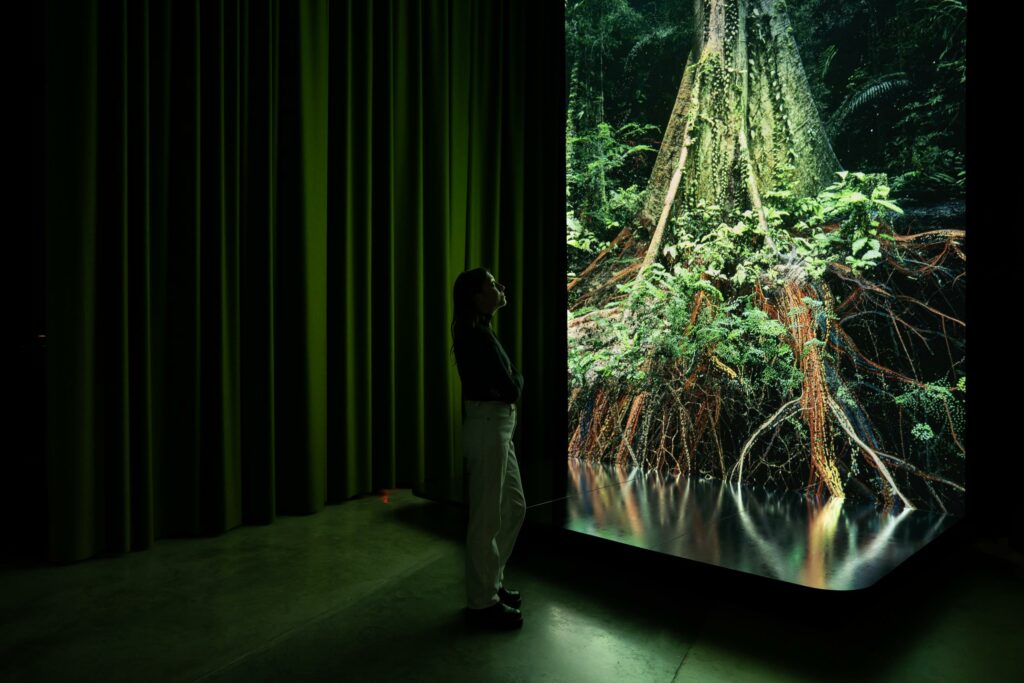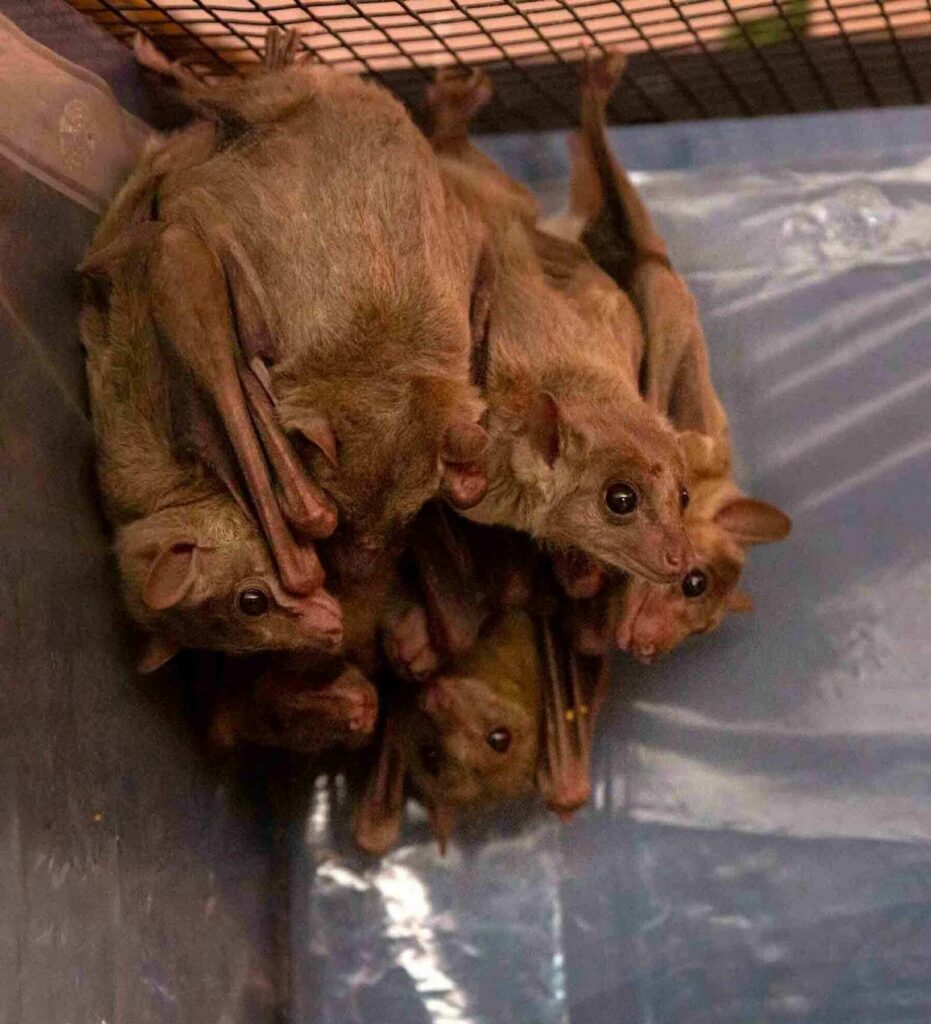PEM takes steps to become more climate-forward, while presenting exhibits that engage visitors in an extended conversation about climate change.
I am a huge fan of bats. I have fond memories of spending summer evenings in my childhood sitting on the porch with my parents, waiting for our attic’s seasonal tenants to take flight into humid night air. When an exhibition titled Bats! opened at the Peabody Essex Museum (PEM), I quickly planned a weekend excursion to Salem.
Bats! completely lived up to my expectations — the name itself accurately captures the whimsy and enthusiasm that imbues the bat-themed exhibition currently taking place in the Dotty Brown Art & Nature Center. This interactive, multisensory exhibition includes contemporary art alongside archival objects from PEM’s collection, hands-on activities alongside educational displays, and pop culture memorabilia alongside an enclosure of live Egyptian fruit bats. All of these elements come together to tell the story of the bat as an often misunderstood cultural icon that also contributes to sustaining a biodiverse ecosystem, and whose species is particularly sensitive to the impact of human-caused environmental threats. In spite of what folk tales may tell us, Bats! reminds visitors that they need not live in fear of vampire bats and asks them to reframe their preconceived notions to understand the vital role bats play in shaping the world around us.
“All of these layers make Bats! a really rich experience,” says Trevor Smith, PEM’s Associate Director of Multisensory Experience and Curator of PEM’s Present Tense Initiative. “It’s something that PEM does really well, building these experiences out of the intersections of things. You’re not just coming for an art history lesson or to better understand science. You get both of those things along the way, but it’s how those layers talk to each other that we begin to understand the complexity of our relationship to another species and the present world.”
With roots going back to the 1799 founding of its precursor organization, the East India Marine Society, the Peabody Essex Museum is the oldest continually operating museum in the United States. “The Art & Nature Center grows out of the fact that, at its origin, PEM was never just an art museum,” Smith explains. “It has always had art, natural history, navigation, architecture — it’s an interesting ground from which to give people the opportunity to think about the world we’re inhabiting and how we want to operate within it.”


Bats! is part of PEM’s Climate + Environment initiative, a program that includes special exhibitions about our changing relationship to the natural world with the goal of sparking conversation, motivating action, and inspiring creative solutions. “[This initiative] started out of a desire to have a longer, sustained conversation with the public than what we could have with one exhibition,” Smith says. “An exhibition is on for three months, and people are maybe only just getting ready to have the conversation when you’re putting things back in the crate.” By stringing together a series of projects, PEM can carry these conversations about climate change and the natural world forward, creating a variety of spaces for visitors to reflect, explore, and enter into these complex global issues.
Recently, PEM opened Our Time on Earth, a traveling exhibition curated by the Barbican in London and co-produced by the Musée de la civilisation in Quebec. This multisensory, immersive show is a cross-disciplinary collaboration of leading thinkers, advocates, researchers, designers, and visual artists. “The show is about our interconnections with all other living species and how we start to imagine a more positive future,” Smith says.
The space is divided into three sections: Belong, Imagine, and Engage. A sign leading visitors into the first section of the show offers a reminder that “A glass of water you drank was once a cloud. The breath you’ve just taken owes its life-giving oxygen to millions of tiny plankton in the ocean or to a majestic rainforest tree. The world’s ecosystems are a beautifully complex network that we all belong to. We need to connect with other species to understand our place in the world.”
The Imagine area uses interactive games, immersive audio and visual installations, and striking creative displays that ask the viewer to consider novel ways to envision the future of the planet. “Each project takes you on a journey into a question, an issue, or a problem-solving scenario,” Smith explains. For the final segment of the show, Engage, the Barbican worked with ten young artist-activists from around the world. “You can visualize these different strategies that people are using and think about how they could possibly be used elsewhere,” Smith says. “It’s a positive-looking show. There’s so much press around the climate emergency, it makes it seem like there is nothing you can do. But, in fact, there are things we can all do … People who come out are very energized by it.”



In conjunction with the Our Time on Earth show, the Barbican developed a sustainability manifesto for all participating museums. “Museums use a lot of resources, there’s no getting around it,” says Smith. “But if you’re going to take on a subject like this, you better be prepared to get your own house in order.” The manifesto highlights some broad, long-term goals for museums (increasing accessibility and diversity, for example) as well as specific sustainability actions we can see being put in place in Our Time on Earth. For example, every item in the exhibition is designed with efficiency, re-use, and circular design as top priorities. All paints used in the space are low-VOC, and all lighting is high-efficiency LED — often, signs that are not being reused across shows are projected with gobo lighting rather than using vinyl appliques on the walls.

In addition to shows PEM produces under the Climate + Environment initiative banner, the museum as a whole has taken impressive strides toward more sustainable practices. PEM has a museum-wide staff group of ideators who meet throughout the year to share information, discuss new opportunities, and propose ideas to help make PEM a more climate-forward institution.
“On the one hand [the climate crisis] is a big topic, on the other hand it’s also an immediate topic. A lot of these debates have been happening all my life — does that mean we failed? Maybe, but there is a lot that has been accomplished along the way,” says Smith. “As a curator, as we move into the next chapter of this institution, we’re thinking about how we create more opportunities for people to have experiences where they can reflect on things that they’re struggling with or engaging with or experiencing in their own lives — sometimes that’s best done through the lens of something that’s a little unfamiliar. Innovation and cultural change always happens — and the power of creativity is always felt — at the intersections of art and science, east and west, high and low. At any time in cultural history, identifying those points is fundamental to understanding how creativity is functioning in society.”
Bats! is on display until July 28th, 2024 and Our Time on Earth is on display until June 9th, 2024. Make plans to visit PEM here.





